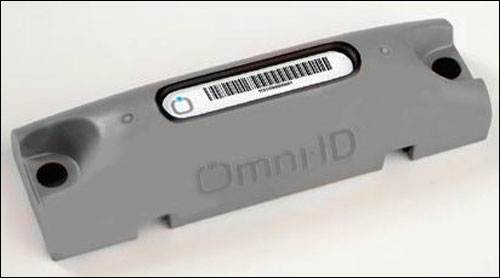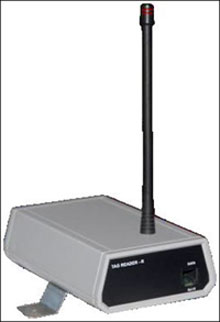Two RFID companies have announced 433 MHz hardware that they claim is the first to comply with a relatively new open air-interface protocol—IEEE 802.15.4f-2012. Omni-ID‘s new Power 415 tag integrates a passive EPC Gen 2 ultrahigh-frequency (UHF) inlay with an active 433 MHz transponder compliant with the IEEE standard, while Guard RFID Solutions‘ Tag Reader Receiver (TRR) has been newly updated to interrogate active 433 MHz tags via the open standard. The two companies each independently tested the interoperability of the reader and the tag last month, and found that the products work well together. During testing, both firms employed Guard RFID’s AllGuard RTLS and Security software, while Omni-ID also used its own software to manage the collected read data.
The 2012 release of the IEEE 802.15.4f standard provided potential users of 433 MHz active RFID tags with the option of building a system based on the open standard that could mix and match products from different vendors. This, however, requires that vendors release such technology using the standard. There are 2.4 GHz RFID readers and tags already available that comply with the IEEE 802.15.4f standard, as well as ultrawide-band (UWB) tags and readers that comply with the standard, including Zebra Technologies‘ Dart sensor, which operates at a range of 6.35 to 6.75 GHz (see RFID Revs Up Pit-Stop Training for Crews of Two NASCAR Drivers and Zebra Releases Dart Sensor to Meet New UWB Standard). However, this week’s announcement by Omni-ID and Guard RFID signals the first technology specific to 433 MHz—another active frequency that is designed to provide a long read range in the presence of metals, and is intended to avoid the busier 2.4 GHz band.

For Omni-ID, the first use of this standard for its 433 MHz products is the Power 415, which combines an active RFID tag containing a UHF inlay made with Impinj‘s Monza X-2K chip, which operates at 860 to 930 MHz and complies with the EPC Gen 2 standard. The Power 415’s active 433 MHz transponder is wired to the passive UHF inlay via the Monza chip’s I²C interface. Users could read or write an Electronic Product Code (EPC) number to the Monza chip’s 128 bits of EPC memory, or other data to the chip’s 2176 bits of user memory, says Ed Nabrotzky, Omni-ID’s executive VP of sales and product development, while the Power 415’s active transceiver could forward that information to a 433 MHz receiver. The use case for the Power 415 tag would include industrial or oil and gas sites containing a large amount of metal and requiring the long read range offered by the tag’s active 433 MHz functionality—up to 400 meters (1,312 feet), according to Omni-ID. Meanwhile, the use of passive UHF RFID functionality in other cases would conserve battery life, and could enable the tag to be read decades after it was applied to an object.
Guard RFID, a British Columbian active RFID company, has been central to developing the 433 MHz communication protocol specified in the IEEE 802.15.4f-2012 standard. Its only offering compliant with that standard is its newly updated TRR reader. However, says Dalibor Pokrajac, Guard RFID’s executive VP of research and development, the company plans to manufacture and sell compliant tags in the future, once other vendors also develop and market readers compliant with IEEE 802.15.4f-2012.
In 2012, an IEEE working group (of which Pokrajac was a member) created a physical layer (PHY) and media access control (MAC) sub-layer to the existing 802.15.4 protocol stack. Those efforts resulted in the creation of the IEEE 802.15.4f-2012 (PHY) amendment. This, he says, enables ultra-low-energy consumption and highly reliable communication to be operated in such a way that is flexible and configurable for a variety of 433 MHz RFID transmission operations, such as from a reader to a tag, a tag to a reader, a reader to a select group of tags (multicast) and one tag to another (unicast).
Omni-ID had been considering the option of offering a Power tag compliant with another 433 MHz RFID standard, ISO 18000-7, a protocol developed largely through the efforts of Savi Technologies—the company that patented the technology that underlies the protocol (see Savi Announces IP Licensing Program for Active RFID Tags and Seven Companies Sign Up for Savi IP License). That technology remains proprietary, Nabrotzky says, since Savi licenses are still required by companies making technology that complies with it. For this reason, he says, the standard has been difficult “to disentangle from the Savi legacy.” One of the biggest users of 18000-7 standard-compliant products is the U.S. government, which still awards the majority of its contracts to Savi.

Developing an IEEE open-standard-based system will be easier for vendors, Nabrotzky says, since they will not have to pay a licensing fee to anyone. “I think you’ll see a lot of expansion” in 433 MHz active RFID technology use in compliance with this open standard, he adds. In the future, Omni-ID intends to offer tags that also comply with IEEE 802.15.4f-2012 but consist of other form factors, such as personnel badges and tags designed for light industrial use, rather than more ruggedized tags like the Power 415. According to Nabrotzky, large oil and gas firms and other Omni-ID customers have been requesting open-standard technology. If such a company requires that kind of technology to manage its work sites or inventory, he notes, the technology vendors will begin development very quickly.
Pokrajac expects the technology will also be well-received by Guard RFID’s industrial customers who sought an open system rather than a proprietary one. Currently, though, Guard RFID Solutions’ TRR is the only 433 MHz reader on the market that complies with IEEE 802.15.4f-2012. “It’s a slow-moving train,” he states, “but once it starts moving, it will be impossible to stop it.”
Pokrajac predicts that the ISO SC31 Committee for ISO 18000-7 working group will also release a revision of the ISO standard in September 2014. The group, on which he serves as a member, “is working on modernization of the 18000-7 standard,” he reports, “by adoption of PHY and MAC layers from IEEE 802.15.4f-2012 and IEEE 802.15.4e-2012.”
Active tags and readers based on this updated standard—to be named ISO 18000-7:2014—will be able to interoperate with 433 MHz tags and readers compliant with IEEE 802.15.4f-2012. What’s more, technology providers of such tags and readers would not be required to purchase a Savi license. With ISO/IEC 18000-7:2014, technology providers would have the option of using the part of the ISO 18000-7:2014 standard that requires Savi licensing or the license-free part based on IEEE 802.15.4f-2012.
“In addition,” Pokrajac says, “in ISO/IEC 18000-7:2014, there is an option to use the exact same data format as in ‘old’ 18000-7, but in payload of new messages, as MAC and PHY are adopted from 802.15.4.”



